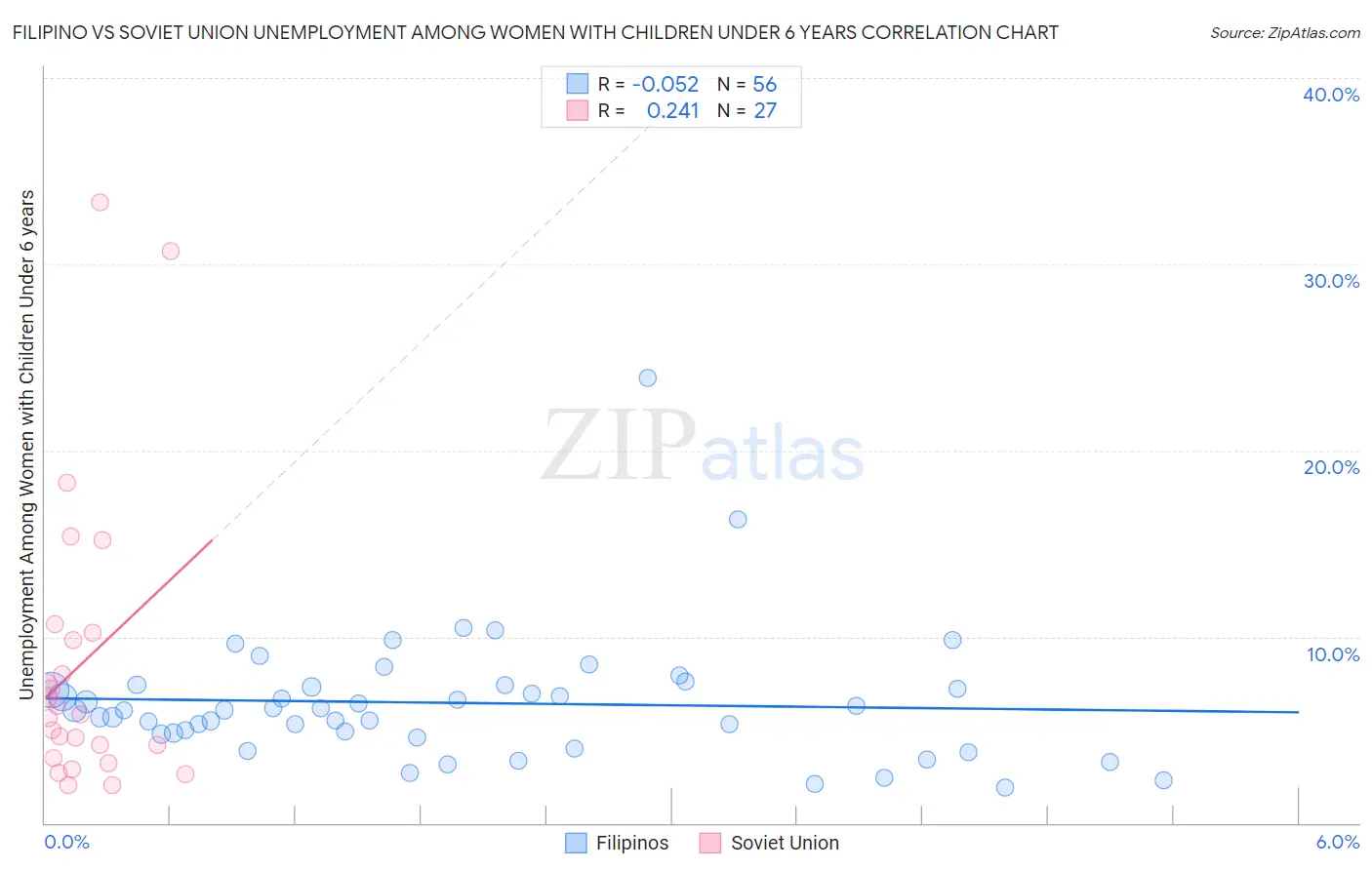Filipino vs Soviet Union Unemployment Among Women with Children Under 6 years
COMPARE
Filipino
Soviet Union
Unemployment Among Women with Children Under 6 years
Unemployment Among Women with Children Under 6 years Comparison
Filipinos
Soviet Union
6.1%
UNEMPLOYMENT AMONG WOMEN WITH CHILDREN UNDER 6 YEARS
100.0/ 100
METRIC RATING
9th/ 347
METRIC RANK
6.5%
UNEMPLOYMENT AMONG WOMEN WITH CHILDREN UNDER 6 YEARS
100.0/ 100
METRIC RATING
25th/ 347
METRIC RANK
Filipino vs Soviet Union Unemployment Among Women with Children Under 6 years Correlation Chart
The statistical analysis conducted on geographies consisting of 208,639,932 people shows a slight negative correlation between the proportion of Filipinos and unemployment rate among women with children under the age of 6 in the United States with a correlation coefficient (R) of -0.052 and weighted average of 6.1%. Similarly, the statistical analysis conducted on geographies consisting of 41,253,072 people shows a weak positive correlation between the proportion of Soviet Union and unemployment rate among women with children under the age of 6 in the United States with a correlation coefficient (R) of 0.241 and weighted average of 6.5%, a difference of 6.4%.

Unemployment Among Women with Children Under 6 years Correlation Summary
| Measurement | Filipino | Soviet Union |
| Minimum | 1.9% | 2.0% |
| Maximum | 23.9% | 33.3% |
| Range | 22.0% | 31.3% |
| Mean | 6.4% | 8.6% |
| Median | 6.1% | 5.8% |
| Interquartile 25% (IQ1) | 4.8% | 3.5% |
| Interquartile 75% (IQ3) | 7.4% | 10.2% |
| Interquartile Range (IQR) | 2.6% | 6.7% |
| Standard Deviation (Sample) | 3.5% | 8.0% |
| Standard Deviation (Population) | 3.4% | 7.8% |
Demographics Similar to Filipinos and Soviet Union by Unemployment Among Women with Children Under 6 years
In terms of unemployment among women with children under 6 years, the demographic groups most similar to Filipinos are Immigrants from India (6.1%, a difference of 0.45%), Taiwanese (6.1%, a difference of 0.94%), Immigrants from China (6.2%, a difference of 1.5%), Indian (Asian) (6.3%, a difference of 2.6%), and Immigrants from Singapore (6.3%, a difference of 2.6%). Similarly, the demographic groups most similar to Soviet Union are Laotian (6.5%, a difference of 0.020%), Cypriot (6.5%, a difference of 0.080%), Bulgarian (6.5%, a difference of 0.16%), Immigrants from Japan (6.5%, a difference of 0.18%), and Immigrants from Korea (6.5%, a difference of 0.36%).
| Demographics | Rating | Rank | Unemployment Among Women with Children Under 6 years |
| Taiwanese | 100.0 /100 | #7 | Exceptional 6.1% |
| Immigrants | India | 100.0 /100 | #8 | Exceptional 6.1% |
| Filipinos | 100.0 /100 | #9 | Exceptional 6.1% |
| Immigrants | China | 100.0 /100 | #10 | Exceptional 6.2% |
| Indians (Asian) | 100.0 /100 | #11 | Exceptional 6.3% |
| Immigrants | Singapore | 100.0 /100 | #12 | Exceptional 6.3% |
| Immigrants | Eastern Asia | 100.0 /100 | #13 | Exceptional 6.3% |
| Immigrants | Bulgaria | 100.0 /100 | #14 | Exceptional 6.3% |
| Thais | 100.0 /100 | #15 | Exceptional 6.3% |
| Immigrants | Uzbekistan | 100.0 /100 | #16 | Exceptional 6.3% |
| Immigrants | Malaysia | 100.0 /100 | #17 | Exceptional 6.4% |
| Assyrians/Chaldeans/Syriacs | 100.0 /100 | #18 | Exceptional 6.5% |
| Mongolians | 100.0 /100 | #19 | Exceptional 6.5% |
| Ute | 100.0 /100 | #20 | Exceptional 6.5% |
| Burmese | 100.0 /100 | #21 | Exceptional 6.5% |
| Immigrants | Korea | 100.0 /100 | #22 | Exceptional 6.5% |
| Bulgarians | 100.0 /100 | #23 | Exceptional 6.5% |
| Laotians | 100.0 /100 | #24 | Exceptional 6.5% |
| Soviet Union | 100.0 /100 | #25 | Exceptional 6.5% |
| Cypriots | 100.0 /100 | #26 | Exceptional 6.5% |
| Immigrants | Japan | 100.0 /100 | #27 | Exceptional 6.5% |